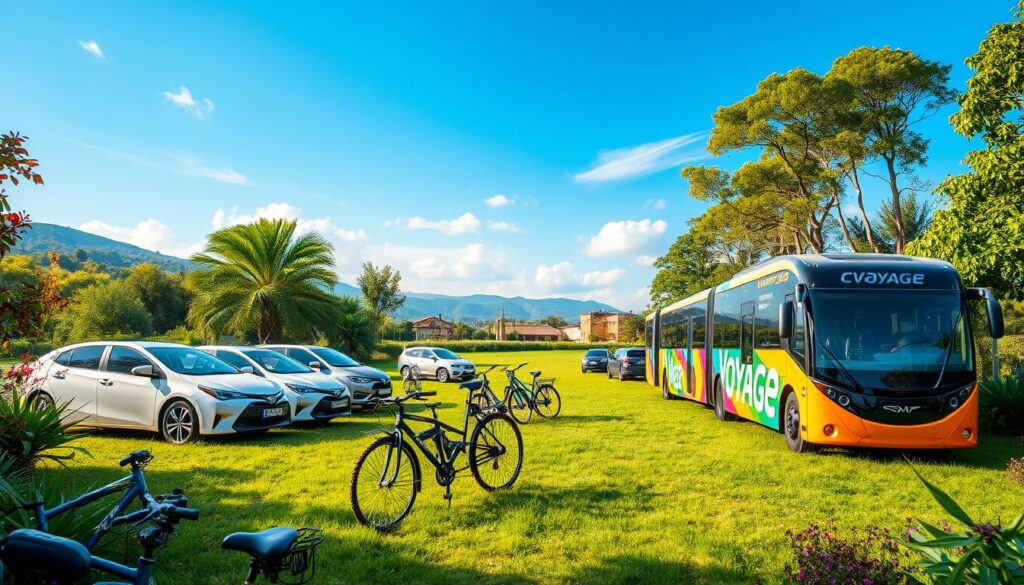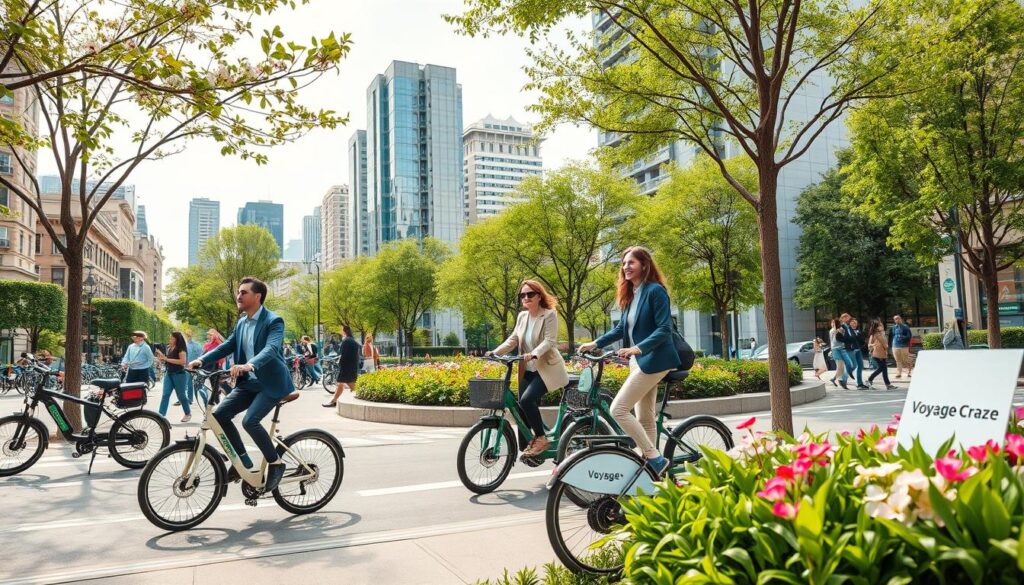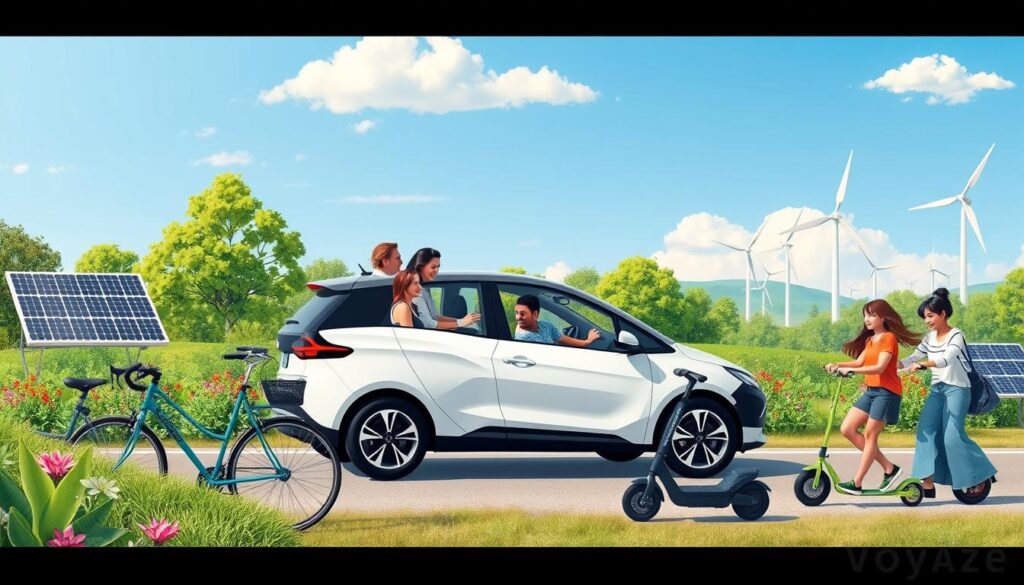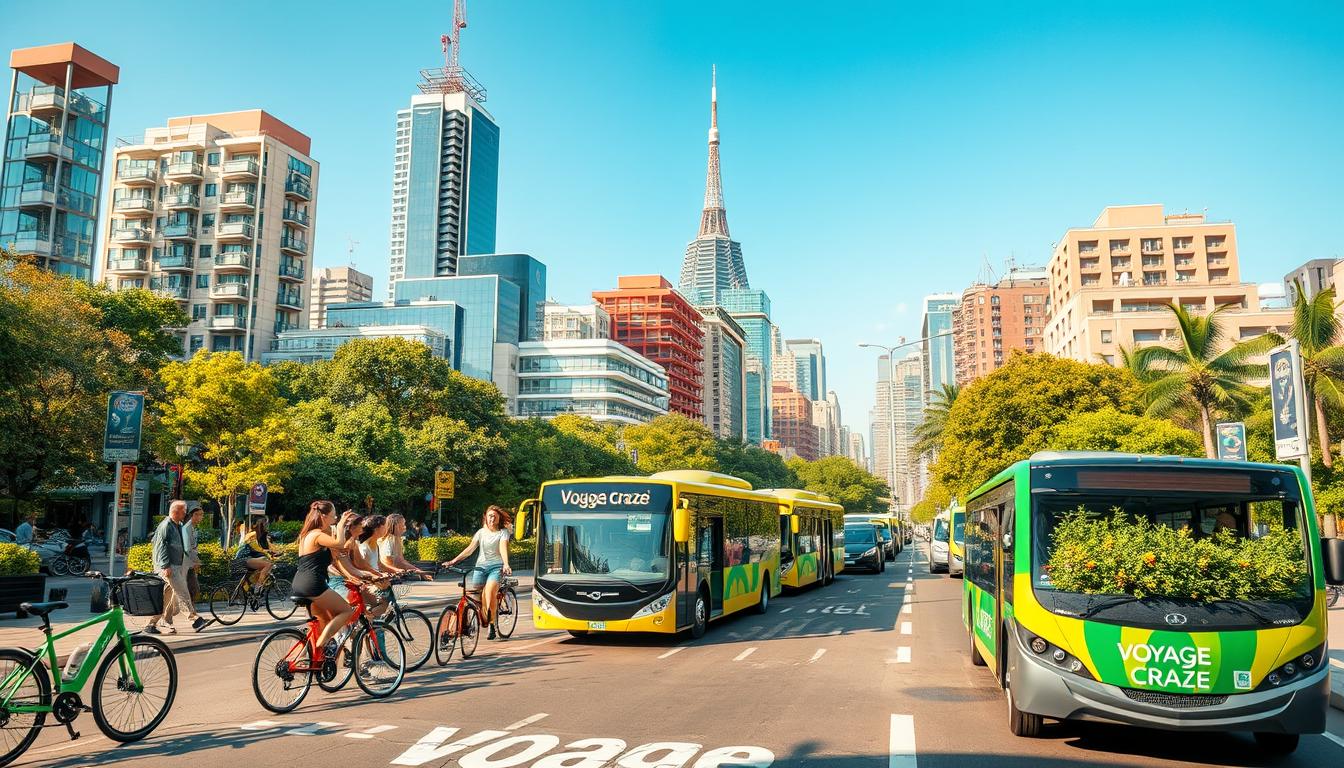As a traveler, you can help the environment by choosing green transport. In San Francisco, millions use private cars, which harms the planet. But, there are better ways like electric cars, bikes, and public transport.
These options cut down on emissions by reducing car use. Cities like San Francisco have many bike lanes, making cycling a good choice. Public transport, like buses and cable cars, is also a green way to travel.
Using eco-friendly transport can greatly reduce our carbon footprint. Tools like hotel finders and flight schedules help us plan trips. They also let us explore green transport options.
Key Takeaways
- Choose eco-friendly transportation options to reduce carbon footprint
- Explore sustainable travel alternatives like electric cars and bicycles
- Use public transit options like buses and trains for green commuting methods
- Incorporate eco-friendly transportation into daily life for a positive impact
- Utilize widgets like hotel finders and flight schedules to enhance travel experience
- Promote sustainable travel by reducing car dependence and using eco-friendly transportation options
Introduction to Eco-Friendly Transportation
The world is moving towards sustainable living, and eco-friendly transit is key. The transport sector is a big source of carbon emissions. So, using low carbon footprint transport is vital to protect our planet. Electric or hybrid vehicles are great alternatives to gas cars.
Choosing sustainable transport has many benefits. It cuts down greenhouse gas emissions and improves air quality. For example, public transport can cut carbon emissions by 95% per passenger mile. Electric vehicles can reduce emissions by 50-80% compared to gas cars.
Understanding Eco-Friendly Options
There are many eco-friendly transport options like walking, cycling, and public transport. These have almost no environmental impact. They don’t emit greenhouse gases or need energy sources. Hybrid or electric cars can also save you about $700 a year on fuel.
Importance of Sustainable Transport
Sustainable transport is very important. It reduces our carbon footprint and improves air quality, which is good for health. It also helps reduce traffic jams, making commutes faster. Electric vehicles can now go over 300 miles on a single charge, and some can recharge to 80% in just 30 minutes.
Benefits of Eco-Friendly Transportation
Choosing earth-conscious transportation modes helps the environment and our health. Eco-conscious travel options like public transport, walking, and cycling reduce carbon emissions. They also make our planet cleaner and healthier.
Green transportation alternatives boost physical activity and cut down air pollution. This is good for our health and the planet.
Some key benefits of sustainable transportation are:
- Reducing carbon emissions and greenhouse gases
- Improving urban air quality and public health
- Promoting physical activity and reducing the risk of chronic diseases
- Supporting local economies and reducing transportation costs
For instance, using public transport for a 20-mile round trip can cut carbon emissions by 4,800 pounds yearly. Also, switching to CNG buses can lower fuel costs by 10% to 20% for cities. Eco-friendly transport helps make our system more sustainable and green.

Exploring eco-friendly transport’s benefits is crucial. Our daily commute affects the environment and our health. By choosing green transport, we help create a cleaner, healthier future.
| Transportation Mode | Carbon Emissions Reduction | Health Benefits |
|---|---|---|
| Public Transportation | 4,800 pounds per year | Reduced risk of chronic diseases |
| Cycling | 1,000 pounds per year | Improved cardiovascular health |
| Walking | 500 pounds per year | Reduced risk of obesity and diabetes |
Public Transportation Systems
Public transportation systems are key in cutting down carbon emissions. They offer eco-friendly ways to travel. Using buses, trains, trams, and subways can greatly reduce our carbon footprint.
For example, choosing public transport over driving alone can cut down CO2 emissions by 20 pounds daily. This adds up to over 48,000 pounds a year.
Benefits of Public Transportation
Public transport has many benefits. It helps lower greenhouse gas emissions, improves air quality, and reduces traffic jams. Here are some key advantages:
- Reduced carbon emissions: Public transport can cut carbon emissions by up to 95% compared to driving alone.
- Improved air quality: Fewer cars on the road means cleaner air, making our environment healthier.
- Decreased traffic congestion: Public transport offers an alternative, easing traffic and making travel easier.
Examples of Successful Public Transportation Systems
Cities like Tokyo and New York have excellent public transport systems. They include buses, trains, trams, and subways. These options make it easy to travel without cars.
By choosing these sustainable travel alternatives, we help make our transport system greener. This benefits our environment and our health.
Bicycles as an Eco-Friendly Mode of Transport
Cycling is a great way to travel that’s good for the planet. It’s a low carbon footprint option that supports clean mobility. When you cycle, you cut down on carbon emissions a lot. This is because bikes don’t produce any emissions, unlike cars that burn fossil fuels.
Some of the benefits of cycling include:
- Reduced carbon emissions: making a car produces about 5.6 tonnes of CO2. But making a bike only produces 96 kg of CO2.
- Improved physical health: cycling regularly can lower the risk of chronic diseases. This can save money on healthcare for both individuals and the system.
- Cost savings: cycling saves money on fuel. The average annual costs for transport in the UK are much higher for cars, buses, and trains compared to bikes.
As cities invest in bike paths, they make it easier to get around. This boosts mobility and improves people’s health. So, cycling is a smart choice for those looking for eco-friendly travel and low carbon options.

Electric Vehicles and Their Impact
The world is moving towards greener ways to travel, and electric vehicles are leading the charge. They have the power to cut down on harmful emissions, making them a top choice for those who care about the planet. In the U.S., cars and trucks are the biggest polluters, so switching to electric is key for a cleaner future.
There are different kinds of electric cars, like ones that run only on electricity and others that can use both electricity and gas. Cars that run only on electricity don’t pollute at all. But, how clean they are depends on where the electricity comes from. As more renewable energy is used, electric cars will get even cleaner.
Having places to charge electric cars is important for their use to grow. The U.S. has over 60,000 public charging spots and more than 162,000 charging ports. As more people want electric cars, building fast-charging stations and new tech will help make owning one easier and more convenient.
Electric cars offer many benefits, including:
- Zero tailpipe emissions, reducing air pollution in urban areas
- Higher energy efficiency, converting approximately 60% of electrical energy into power at the wheels
- Reduced greenhouse gas emissions, contributing to a more sustainable future
Carpooling and Ridesharing
Carpooling and ridesharing are great ways to cut down on air pollution and greenhouse gas emissions. They help reduce the number of cars on the road. Plus, they make travel more affordable by sharing costs like fuel and parking.
Recent stats show that 44% of car trips in the US have just one person. This means carpooling and ridesharing can really make a difference. Platforms like AlterNetWays help people find rides with others going the same way.
- Reduced air pollution and greenhouse gas emissions
- Cost savings through shared fuel, tolls, and parking costs
- Decreased traffic congestion and shorter commute times
- Increased social connectedness and community engagement

By supporting carpooling and ridesharing, we can make our transportation system greener. It helps us use fewer cars and lowers our carbon footprint. As we look for ways to travel more sustainably, carpooling and ridesharing will be key.
Walking: The Original Eco-Friendly Option
Walking is a great way to travel that’s good for the planet. It’s also good for your health. By walking more, we can use less fossil fuel and choose cleaner ways to get around.
Health Benefits of Walking
Walking often can lower the risk of serious diseases like heart disease and diabetes. It also boosts your mood and overall health. Studies show walking can make commutes shorter and safer, making it a smart choice for the environment.
Urban Design for Pedestrians
Designing cities for walkers is key. We need safer, wider paths for both walkers and bikers. Cities should also make it easy to park bikes and put walkers first in city centers.
The idea of the “15 Minute City” is to make everything within a 15-minute walk or bike. This means cities should be close, diverse, dense, and full of life.
Walking and other active ways to travel have many benefits. They can save on healthcare costs, cut down on carbon emissions, and make us happier and healthier.
Choosing to walk and use other green ways to travel helps make our transportation system better. It supports clean and sustainable choices for getting around.
| Mode of Transportation | Carbon Footprint Reduction |
|---|---|
| Walking | Up to 1,000 pounds (0.5 tons) of CO2e annually |
| Riding Public Transportation | Up to 6,000 pounds (3 tons) of CO2e annually |
| Carpooling | Up to 2,000 pounds (1 ton) of CO2e annually |
Emerging Technologies in Transportation
The world is moving towards greener ways to travel. New options like the hyperloop are being developed. This technology could make traveling between cities much faster, reaching speeds of up to 700 mph.
Autonomous electric vehicles are also on the rise. They can drive more efficiently, cutting down on fuel use and emissions. Electric vehicle sales jumped by 65% in 2022, showing more people want green travel. Companies like Virgin Hyperloop One and United Airlines are also working on new projects.
These new technologies offer many benefits. They help reduce carbon emissions, improve air quality, and make travel more efficient. These green options are not only good for the planet but also offer a unique travel experience.
As technology keeps improving, we’ll see even more eco-friendly travel options. This will make green transportation more accessible and appealing to everyone.
The Role of Policy in Eco-Friendly Transport
The world is moving towards greener transport, and policy plays a big role. Governments are launching initiatives and offering incentives for green travel. For example, they invest in electric vehicle infrastructure and give tax breaks to companies using sustainable transport.
Some key policy actions include:
- Setting emission standards for vehicles
- Boosting public transport systems
- Building bike-friendly roads
- Offering perks for companies using green transport
These policies cut down on carbon emissions and improve air quality. They make cities healthier and more pleasant. By backing eco-friendly transport, we ensure a better future for all.
Technology, like smart traffic systems, is also vital. It helps manage traffic better, encouraging the use of public transport, walking, and cycling. This way, cities can reduce congestion and promote greener travel.
| Policy Initiative | Benefits |
|---|---|
| Investing in public transportation | Reduced congestion, improved air quality |
| Creating bike-friendly infrastructure | Increased cycling, reduced carbon footprint |
| Offering incentives for sustainable transportation | Encourages companies to adopt eco-friendly practices |
Case Studies of Eco-Friendly Cities
Cities worldwide are embracing environmentally friendly transit solutions to cut down on carbon emissions. These efforts not only help the planet but also make life better for locals. For example, Copenhagen and Buenos Aires aim to be carbon neutral. They focus on low carbon footprint transportation.
Examples from the US
In the US, New York and San Francisco are at the forefront. They’ve adopted eco-friendly transport like electric buses and bike-sharing. This move has lowered their carbon footprint and made the air cleaner.
International Examples
Abroad, cities like Copenhagen and Buenos Aires are also making big changes. Copenhagen plans to be carbon neutral by 2025, focusing on low carbon footprint transportation. Buenos Aires has built a network of bike lanes and public transport. This has cut down travel times and improved air quality.
Innovations in Eco-Friendly Transport
The world faces big challenges with climate change, and the transport sector must change. Sustainable aviation fuels are a big step forward. They could cut carbon emissions from flying by up to 80%. Boeing is leading the way, looking into fuels made from algae and waste.
Green shipping is also growing. Shipping is a big source of greenhouse gas emissions, making eco-friendly practices key. Wind-assisted systems and better routes are just a few examples of how shipping can be greener.
Electric and hybrid cars are becoming more common too. They cut down on carbon emissions and save money. As we move towards a greener future, expect more green transport ideas to come up.
- Less carbon emissions
- Lower costs
- Better air quality
- More energy efficiency
We can all help by choosing greener travel options. By doing so, we reduce our carbon footprint and help the planet.
Challenges Facing Eco-Friendly Transportation
The world is working hard to make transportation more sustainable. Eco-friendly transportation options struggle with not enough charging stations for electric cars. Also, many cities lack bike lanes, making it hard to use green commuting methods.
Changing how people travel is another big challenge. It requires a shift in public behavior and mindset. This makes it tough to adopt sustainable travel alternatives.
But, there are steps being taken to solve these problems. Governments and companies are working to add more charging spots and improve city planning. They want to make cities better for walking, biking, and using public transport.
There are also efforts to teach people about the benefits of green travel. By spreading the word, more people might choose eco-friendly ways to get around. This could lead to a cleaner, healthier future for all of us.







